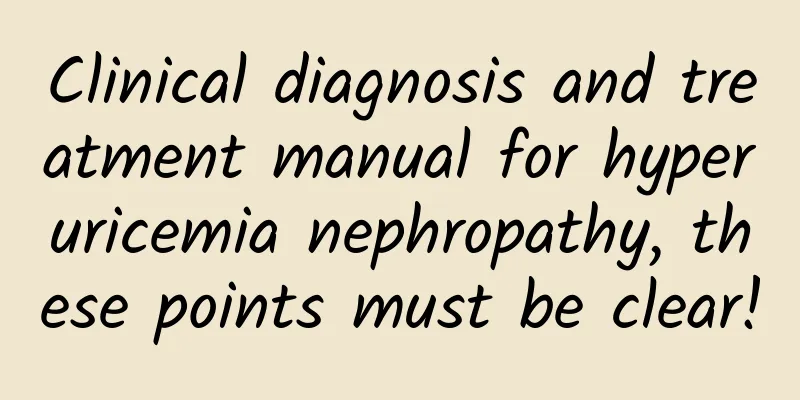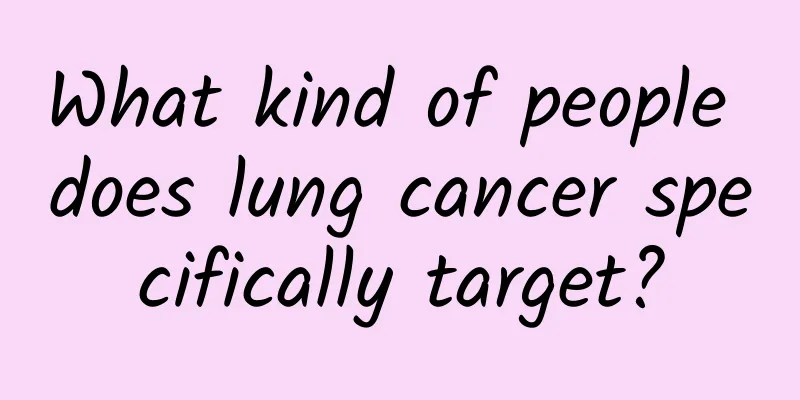Clinical diagnosis and treatment manual for hyperuricemia nephropathy, these points must be clear!

|
With the improvement of people's living standards and changes in dietary structure, the prevalence of hyperuricemia is gradually increasing. Studies have confirmed that hyperuricemia is an important cause of the increase in the prevalence of chronic kidney disease and a risk factor for further development into hyperuricemia nephropathy. If hyperuricemia progresses to hyperuricemia nephropathy uncontrollably in the early stages, the following clinical diagnosis and treatment matters must be paid attention to to prevent its further development and damage to kidney health. Diagnosis of hyperuricemia nephropathy requires two conditions Hyperuricemia nephropathy refers to kidney disease caused by the deposition of urate in renal tissue, which is called hyperuricemia nephropathy. According to the recommendations of international guidelines, the diagnosis of hyperuricemia nephropathy must meet two conditions [1]: first, primary hyperuricemia, with serum uric acid >420 μmol/L in men and >360 μmol/L in women, in addition to secondary hyperuricemia caused by other kidney diseases, blood diseases, tumors, chemotherapy, and thiazide diuretics; second, hyperuricemia nephropathy can only be diagnosed if there is proteinuria or hematuria, renal impairment, or urinary stones, in addition to other factors of renal damage. Clinical manifestations of hyperuricemia nephropathy at different stages Based on clinical characteristics, hyperuricemia nephropathy can be divided into acute uric acid nephropathy, chronic uric acid nephropathy and uric acid kidney stones. The specific characteristics are shown in Table 1[2]. Table 1 Characteristics of hyperuricemia nephropathy at different stages Treatment of hyperuricemia nephropathy: inhibition, promotion, and degradation Studies have shown that lowering blood uric acid levels can slow the progression of kidney disease. The treatment of hyperuricemia nephropathy focuses on preventing and correcting hyperuricemia, lowering blood uric acid levels, and preventing urate from depositing in the kidneys. The main treatment methods include drug therapy and non-drug therapy. There are three types of commonly used uric acid-lowering drugs, namely drugs that inhibit uric acid synthesis, drugs that increase uric acid excretion, and drugs that promote uric acid decomposition [3]. When the renal function is normal or slightly impaired, the daily uric acid excretion is normal (<4.8 mmol/L), and there are no kidney stones, it is advisable to use drugs that promote uric acid excretion; if renal insufficiency occurs and the daily uric acid excretion increases (>4.8 mmol/L), it is advisable to use drugs that inhibit uric acid synthesis. When uric acid levels are significantly elevated and a large number of tophi are deposited, the two drugs can also be used together. Drugs that inhibit uric acid synthesis. The main representative drug is allopurinol, which is a commonly used uric acid-lowering drug in clinical practice. Start with 0.05 g each time, 2 to 3 times a day, and gradually increase the dose. After 2 to 3 weeks, increase to 0.2 to 0.4 g per day, divided into 2 to 3 doses. Regularly monitor the uric acid level in the blood and urine. If it has reached the normal level, no more increase will be made; if it is still high, it can be increased again, and the maximum dose does not exceed 0.6 g. Uric acid transfer gout attacks may occur during medication, which can be supplemented with colchicine treatment. Common adverse reactions include skin allergies, bone marrow transplantation, diarrhea, abdominal pain, and low fever. Patients with renal insufficiency are prone to accumulation in the body due to blocked excretion, which increases adverse reactions and should reduce the dosage appropriately. In addition, there is also Febuxostat, which can inhibit the formation of uric acid in the body and is contraindicated for patients with severe renal failure. Drugs that increase uric acid excretion. This type of drug increases uric acid excretion mainly by inhibiting the active reabsorption of uric acid by the renal tubules. The representative drug is benzbromarone. The initial dose is 25-50 mg/d, and the maximum dose is 150 mg/d. Check the blood uric acid concentration after 1-3 weeks of medication. At the same time, drink more water to increase urine volume and promote uric acid excretion. In the first two weeks of medication, sodium bicarbonate or citric acid mixture can be given as appropriate to maintain the patient's urine pH at 6.2-6.9. The main adverse reactions are gastrointestinal reactions. It is contraindicated for patients who are allergic to benzbromarone, have severe renal damage, or have severe kidney stones. Promote the decomposition of uric acid. The main drugs include rasburicase and polyethylene glycol uricase. Rasburicase is a recombinant uricase that promotes the conversion of uric acid to reduce blood uric acid levels. It is often used to treat and prevent acute hyperuricemia caused by tumor lysis syndrome caused by tumor chemotherapy. Polyethylene glycol uricase can catalyze the oxidation of uric acid into more soluble allantoin, which is quickly excreted from the urine. It is used to lower uric acid and reduce the deposition of urate crystals. It is used for patients with severe chronic gout who are ineffective with conventional therapies. Both drugs have been approved for marketing in the United States, but are not yet available in my country. summary In short, the treatment of hyperuricemia nephropathy focuses on preventing and correcting hyperuricemia, lowering blood uric acid levels, and preventing urate deposition. In addition, it is necessary to actively treat metabolic risk factors related to elevated blood uric acid to prevent further development of hyperuricemia nephropathy. References: [1] Zhang Shuyan. Clinical characteristics and diagnosis of hyperuricemia nephropathy[J]. Chinese Journal of Postgraduate Medical Education, 2004(s1):159-160. [2] Zhang Lu, Yang Dingwei. Advances in the diagnosis and treatment of hyperuricemia nephropathy[J]. Chinese Journal of Clinical Physicians (Electronic Edition), 2019, 13(06): 457-462. [3] Liu Hong, Tang Yuchang, Liu Bicheng. Diagnosis and treatment of hyperuricemia nephropathy based on the survey data of hyperuricemia in my country[J]. Drug Evaluation, 2014, 11(23): 6-10+29. |
>>: Silver Age Health | Safety Management for Frail Elderly People
Recommend
What is the normal age for menopause?
Menopause is a stage that every woman will go thr...
Milk or soy milk, which one is more "nutritious"?
Milk or soy milk, which one has higher nutritiona...
Why is the woman's face pale?
The face has no blood color, that is, it is pale....
How to grow sweet potatoes? The growing environment of sweet potatoes
Sweet potatoes are a very common food in our dail...
Black blood on the first day of menstruation
When menstruation just starts, the blood is a lit...
Why does a woman leak urine?
Some women experience urine leakage after giving ...
What is the reason for the ovulation test paper to be weak positive two days before menstruation?
There are many things that women need to pay atte...
Misdiagnosis of polyps by endometrial ultrasound during proliferative phase
The symptoms of misdiagnosed polyps in the prolif...
What should pregnant women do if they have indigestion?
Indigestion in pregnant women's stomach is a ...
[Medical Q&A] Is bone cement cement?
Planner: Chinese Medical Association Reviewer: Ha...
What are the symptoms of menopause at the age of 42?
Many women experience menopause at the age of 42 ...
How harmful is staying up late? How to remedy it in time? Sleep knowledge post to help you
Some time ago, the topic of a 24-year-old man who...
What is the reason for lower back pain when you are pregnant?
Pregnancy is an experience that is difficult for ...
Can eating pumpkin and corn lower blood sugar? My parents have been eating them for many years, but they don’t know the inside story…
Expert of this article: Dou Pan, deputy director ...









